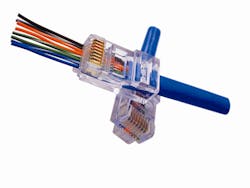Editor's Note: Watch Tim O’Leary’s video of this procedure at www.locksmithledger.com/12036707
The ends of your network cables have to be ‘happy’ for your equipment to function. As more and more security equipment is transitioning to UTP and network cabling, I thought it would useful to some readers to show you how to install RJ45 connectors.
I have been converted to Platinum Tools EZ RJ-45 connectors. They allow the wires to pass through the connector so you can verify the order they are in is correct and also that when crimped, each wire will get securely fastened. With traditional RJ-45 connectors, the wires are inserted into grooves in the connector but do not pass through. It is not uncommon for the wires to change their order or not get inserted adequately into the connector. The results may vary; varying degrees of malfunctions: poorly crimped, miswired or both. Once you crimp an RJ 45, that’s it. If it doesn’t work, you cut it off, toss it and start over.
We recommend testing the cables once the connectors are applied, but before you connect the cables to the hardware.
I’ve used many testers. There are very expensive network certification devices which provide a concise evaluation of each conductor verifying it is connected properly, and the overall cable is performing to the specification called for in the specification. You can generate a printout of the test results which you submit to the customer so he’ll pay you.
At the other end of the spectrum, you can get a tester off eBay for about $10. I’ve had such disappointing experiences with these that I stopped using them. The ones I used were not dependable for testing longer cables, and were very delicate.
My trainee ran through a bag of regular RJ 45 connectors and blew up a couple of testers by connecting miswired cables to a live PoE switch on one end and a Hong Kong Express Tester on the other. He took forever assembling the cables, skipped the dry test step before applying power, and scared the client.
So a decent tester is a good starting point, and connectors that do not require extremely good eye sight and dexterity are really important details.
I hope you enjoy the video and happy endings to you!
Tim O'Leary
Tim O'Leary is a security consultant, trainer and technician who has also been writing articles on all areas of locksmithing & physical security for many years.






